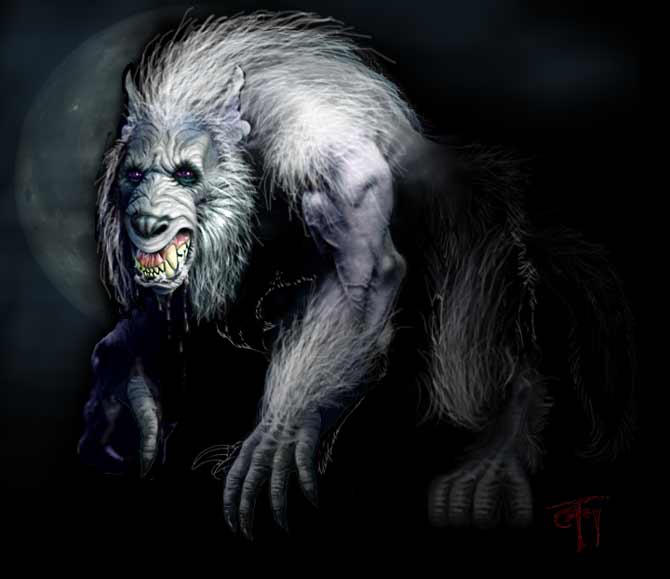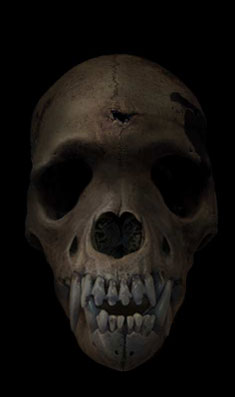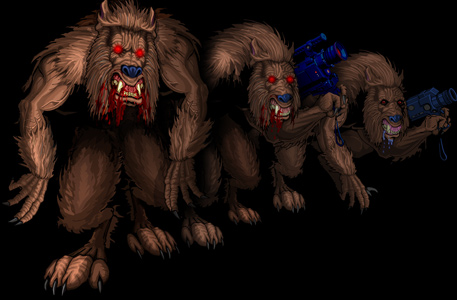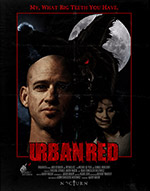2,000 BC --
Epic of Gilamesh written down (first
literary reference to werewolves)
850 BC --
Odyssey written down (includes many traces of werewolf beliefs)
500 BC --
Herodotus in his Histories States The Amazons, who worshipped the Triple Goddess, incorporated a tribe called the Neuri, who "turned themselves into wolves" for a few days each year during their main religious festival. The same story was told of a certain Irish tribe in Ossory, who became wolf-people when attending their yuletide feast, devouring the flesh of cattle as wolves, and afterward regaining their human shape.
400 BC --
Damarchus, Arcadian werewolf, won boxing medal at Olympics
100 - 75 BC --
Virgil's eighth ecologue (first voluntary transformation of werewolf)
60 AD --
In the Latin work of prose, the Satyricon, by
Gaius Petronius Arbiter, one of the characters, Niceros, tells a story
at a banquet about a friend who turned into a wolf (chs. 61-62). He describes
the incident as follows, "When I looked for my friend I saw he'd stripped and piled his clothes by the roadside...He urinated in a circle round his clothes and then, just like that, turned into a wolf!...after he turned into a wolf he started howling and then ran off into the woods."
249 - 251 AD --
According to Irish stories of saints, Christopher is born a pagan Dog-head called Reprobus. He regrets his beastial nature and is overjoyed when his conversion to Christianity allows him to lose his Cynocephalic nature. An eighth-century list of Saints explained that Christopher "was one of the Dog-heads, a race that had the heads of dogs and ate human flesh. He meditated much on God, but at that time could only speak the language of the Dog-heads."As time passed, the writings mentioned less and less of Christopher's Cynocephalic nature. Walter of Speyer wrote, in the tenth century, stated that Christopher "took his origins from the Cynocephali, a people in speech and countanence dissimilar to others."Sait Christopher was more popularly pictured as a giant carrying the christ child. This still satisfied that Christopher was a convert from a monstrous race. But it was probably more due to the fact that Christopher literally means Christ carrier.
170 AD --
Pausanias visits Arcadia and hears of Lykanian werewolf
rites.
600 AD --
Saint Albeus (Irish) said to have been suckled by wolves.
617 AD --
Wolves said to have attacked heretical monks.
650 AD --
Paul of Aegina or Paulus Aegineta was
a Byzantine Greek physician best known for writing the medical
encyclopedia Medical
Compendium in Seven Books. For many years in the Byzantine
Empire, this work contained the sum of all Western medical
knowledge and was unrivaled in its accuracy and completeness.
Within this compendium Paul describes "melancholic
lycanthropia".
1020 AD --
First use of the word "werewulf" recorded in English.
April 24, 1101 AD --
Death of Prince
Vseslav Bryachislavich of Polock (also known as Vseslav the Sorcerer or Vseslav
the Seer) , alleged Ukrainian
werewolf.
1182 - 1183 AD --
Giraldus Cabrensis claims to have discovered Irish
werewolf couple.
Here a traveling
Priest spends a night in a forest and is accosted by a talking wolf.
Although terrified, the Priest is quickly disarmed when the wolf offers
praise to God and supplies correct catholic answers to the
Priest's questions ( Does that prove anything,
outside of the idea that the werewolf was catholic? ). The wolf explains
that he and his wife are cursed and "compelled
every seven years to put off the human form and depart the dwellings
of men. Quitting entirely the human form, we assume that of wolves."The
wolf then explains that his wife is dying and impels the Priest to administer
the last rights. Stunned, the Priest does so. The female wolf does indeed
pass away, uttering as she does so, 'Now, though my body dies in its
present form, my immortal soul shall be with God.'The
male wolf spends the night with the Priest and, in the morning, leads
him out of the forest, thanking him profusely. Later, the Priest has
a crisis of confidence about what has occurred, providing holy sanction
to an accursed creature and seeks absolution from the Pope. Online
Source : Cabrensis, Giraldus: Topographia
Hibernica
1275 - 1300 AD --
Völsunga saga,
Germanic werewolf saga, commited to paper.
1344 AD --
Wolf child of Hesse discovered.
1407 AD --
Werewolves mentioned during witchcraft trial at Basel
1450 AD --
Else of Meerburg accused of riding a wolf.
1494 AD --
Swiss woman tried for riding a wolf.
1495 AD --
Woman tried for riding a wolf at Lucerne.
1521 AD --
Werewolves of Poligny burnt.
1541 AD --
Paduan werewolf dies after having arms and legs cut
off.
1550 AD --
Witekind interviews self-confessed werewolf at Riga
Johann Weyer takes up post of doctor at Cleve.
1555 AD --
Olaus Magnus records strange behavior of Baltic werewolves.
1573 AD --
Gilles Garnier burnt as werewolf.
1588 AD --
Alleged date of Auvergne female werewolf (Boguet).
1589 AD --
Peter Stubb executed as werewolf at Cologne.
1598 AD --
Pernette Gandillon was a poor girl in the Jura, who ran about the country on all fours, in the belief that she was a wolf. One day as she was ranging the country in a fit of lycanthropic madness, she came upon two children who were plucking wild strawberries. Filled with a sudden passion for blood, she flew at the little girl and would have brought her down, had not her brother, a lad of four years old, defended her lustily with a knife. Pernette, however, wrenched the weapon from his tiny hand, flung him down and gashed his throat, so that he died of the wound. Pernette was torn to pieces by the people in their rage and horror.
Directly after, Pierre, the brother of Pernette Gandillon, was accused of witchcraft. He was charged with having led children to the sabbath, having made hail, and having run about the country in the form of a wolf. The transformation was effected by means of a salve which he had received from the devil. He had on one occasion assumed the form of a hare, but usually he appeared as a wolf, and his skin became covered with shaggy grey hair. He readily acknowledged that the charges brought against him were well founded, and he allowed that he had, during the period of his transformation, fallen on, and devoured, both beasts and human beings. When he desired to recover his true form, he rolled himself in the dewy grass. His son Georges asserted that he had also been anointed with the salve, and had gone to the sabbath in the shape of a wolf. According to his own testimony, he had fallen upon two goats in one of his expeditions.
One Maundy-Thursday night he had lain for three hours in his bed in a cataleptic state, and at the end of that time had sprung out of bed. During this period he had been in the form of a wolf to the witches' sabbath.
His sister Antoinnette confessed that she had made hail, and that she had sold herself to the devil, who had appeared to her in the shape of a black he-goat. She had been to the sabbath on several occasions.
Pierre and Georges in prison behaved as maniacs, running on all fours about their cells and howling dismally. Their faces, arms, and legs were frightfully scarred with the wounds they had received from dogs when they had been on their raids. Boguet accounts for the transformation not taking place, by the fact of their not having the necessary salves by them.
All three, Pierre, Georges, and Antoinnette, were hung and burned.Source: Boguet's Discours de Sorciers, 1603-1610.
In a wild and unfrequented spot
near Caude, some countrymen came one day upon the
corpse of a boy of fifteen, horribly mutilated
and bespattered with blood. As the men approached,
two wolves, which had been rending the body, bounded
away into the thicket. The men gave chase immediately,
following their bloody tracks till they lost them;
when suddenly crouching among the bushes, his teeth
chattering with fear, they found a man half naked,
with long hair and beard, and with his hands dyed
in blood. His nails were long as claws, and were
clotted with fresh gore, and shreds of human flesh.The
man, whose name was Jacques Roulet, of his own
accord stated that he had fallen upon the lad and
had killed him by smothering him, and that he had
been prevented from devouring the body completely
by the arrival of men on the spot. Before the judges,
Roulet acknowledged that he was able to transform
himself into a wolf by means of a salve which his
parents had given him. When questioned about the
two wolves which had been seen leaving the corpse,
he said that he knew perfectly well who they were,
for they were his companions, Jean and Julian,
who possessed the same secret as himself. He was
shown the clothes he had worn on the day of his
seizure, and he recognized them immediately; he
described the boy whom he had murdered, gave the
date correctly, indicated the precise spot where
the deed had been done, and recognized the father
of the boy as the man who had first run up when
the screams of the lad had been heard. In prison,
Roulet behaved like an idiot. When seized, his
belly was distended and hard; in prison he drank
one evening a whole pailful of water, and from
that moment refused to eat or drink. The lieutenant
criminel (chief magistrate) sentenced Roulet to
death. He, however, appealed to the Parliament
at Paris; and this decided that as there was more
folly in the poor idiot than malice and witchcraft,
his sentence of death should be commuted to two
years' imprisonment in a madhouse, that he might
be instructed in the knowledge of God, whom he
had forgotten in his utter poverty.
14th of December 1598 AD --
A tailor of Chalons was sentenced to the flames by the Parliament of Paris for lycanthropy.
This wretched man had decoyed children into his shop, or attacked them in the gloaming when they strayed in the woods, had torn them with his teeth, and killed them, after which he seems calmly to have dressed their flesh as ordinary meat, and to have eaten it with great relish.
The number of little innocents whom he destroyed is unknown. A whole cask full of bones was discovered in his house. The man was perfectly hardened, and the details of his trial were so full of horrors and abominations of all kinds, that the judges ordered the documents to be burned.
1603 AD --
One fine afternoon in the spring, some village girls were tending their
sheep on the sand-dunes which intervene between the vast forests of pine
covering the greater portion of the present department of Landes in
the south of France, and the sea.
The brightness of the sky, the freshness of the air
puffing up off the blue twinkling Bay of Biscay, the hum or song of the
wind as it made rich music among the pines which stood like a green uplifted
wave on the East, the beauty of the sand-hills speckled with golden cistus,
or patched with gentian-blue, by the low growing Gremille couchée,
the charm of the forest-skirts, tinted variously with the foliage of
cork-trees, pines, and acacia, the latter in full bloom, a pile of rose-coloured
or snowy flowers,--all conspired to fill the peasant maidens with joy,
and to make their voices rise in song and laughter, which rung merrily
over the hills, and through the dark avenues of evergreen trees.
Now a gorgeous butterfly attracted their attention, then a flight of
quails skimming the surface.
"Ah!" exclaimed Jacquiline Auzun," ah, if I had my stilts
and bats, I would strike the little birds down, and we should have a
fine supper."
"Now, if they would fly ready cooked into one's mouth, as they
do in foreign parts!" said another girl.
"Have you got any new clothes for the S. Jean?" asked a third; "my
mother has laid by to purchase me a smart cap with gold lace."
"You will turn the head of Etienne altogether, Annette!" said
Jeanne Gaboriant. "But what is the matter with the sheep?"
She asked because the sheep which had been quietly browsing before her,
on reaching a small depression in the dune, had started away as though
frightened at something. At the same time one of the dogs began to growl
and show his fangs.
The girls ran to the spot, and saw a little fall in the ground, in which,
seated on a log of fir, was a boy of thirteen. The appearance of the
lad was peculiar. His hair was of a tawny red and thickly matted, falling
over his shoulders and completely covering his narrow brow. His small
pale-grey eyes twinkled with an expression of horrible ferocity and cunning,
from deep sunken hollows. The complexion was of a dark olive colour;
the teeth were strong and white, and the canine teeth protruded over
the lower lip when the mouth was closed. The boy's hands were large and
powerful, the nails black and pointed like bird's talons. He was ill
clothed, and seemed to be in the most abject poverty. The few garments
he had on him were in tatters, and through the rents the emaciation of
his limbs was plainly visible.
The girls stood round him, half frightened and much surprised, but the
boy showed no symptoms of astonishment. His face relaxed into a ghastly
leer, which showed the whole range of his glittering white fangs.
"Well, my maidens," said he in a harsh voice, "which
of you is the prettiest, I should like to know; can you decide among
you?"
"What do you want to know for?" asked Jeanne Gaboriant, the
eldest of the girls, aged eighteen, who took upon herself to be spokesman
for the rest.
"Because I shall marry the prettiest," was the answer.
"Ah!" said Jeanne jokingly; "that is if she will have
you, which is not very likely, as we none of us know you, or anything
about you."
"I am the son of a priest," replied the boy curtly.
"Is that why you look so dingy and black?"
"No, I am dark-coloured, because I wear a wolf-skin sometimes."
"A wolf-skin!" echoed the girl; "and pray who gave it
you?"
"One called Pierre Labourant."
"There is no man of that name hereabouts. Where does he live?"
A scream of laughter mingled with howls, and breaking into strange gulping
bursts of fiendlike merriment from the strange boy.
The little girls recoiled, and the youngest took refuge behind Jeanne.
"Do you want to know Pierre Labourant, lass? Hey, he is a man with
an iron chain about his neck, which he is ever engaged in gnawing. Do
you want to know where he lives, lass? Ha., in a place of gloom and fire,
where there are many companions, some seated on iron chairs, burning,
burning; others stretched on glowing beds, burning too. Some cast men
upon blazing coals, others roast men before fierce flames, others again
plunge them into caldrons of liquid fire."
The girls trembled and looked at each other with scared faces, and then
again at the hideous being which crouched before them.
"You want to know about the wolf-skin cape?" continued he. "Pierre
Labourant gave me that; he wraps it round me, and every Monday, Friday,
and Sunday, and for about an hour at dusk every other day, I am a wolf,
a were-wolf. I have killed dogs and drunk their blood; but little girls
taste better, their flesh is tender and sweet, their blood rich and warm.
I have eaten many a maiden, as I have been on my raids together with
my nine companions. I am a were-wolf! Ah, ha! if the sun were to set
I would soon fall on one of you and make a meal of you!" Again he
burst into one of his frightful paroxysms of laughter, and the girls
unable to endure it any longer, fled with precipitation.
Near the village of S. Antoine de Pizon, a little girl of the name of
Marguerite Poirier, thirteen years old, was in the habit of tending her
sheep, in company with a lad of the same age, whose name was Jean Grenier.
The same lad whom Jeanne Gaboriant had questioned.
The little girl often complained to her parents of the conduct of the
boy: she said that he frightened her with his horrible stories; but her
father and mother thought little of her complaints, till one day she
returned home before her usual time so thoroughly alarmed that she had
deserted her flock. Her parents now took the matter up and investigated
it. Her story was as follows:--
Jean had often told her that he had sold himself to the devil, and that
he had acquired the power of ranging the country after dusk, and sometimes
in broad day, in the form of a wolf. He had assured her that he had killed
and devoured many dogs, but that he found their flesh less palatable
than the flesh of little girls, which he regarded as a supreme delicacy.
He had told her that this had been tasted by him not unfrequently, but
he had specified only two instances: in one he had eaten as much as he
could, and had thrown the rest to a wolf, which had come up during the
repast. In the other instance he had bitten to death another little girl,
had lapped her blood, and, being in a famished condition at the time,
had devoured every portion of her, with the exception of the arms and
shoulders.
The child told her parents, on the occasion of her return home in a
fit of terror, that she had been guiding her sheep as usual, but Grenier
had not been present. Hearing a rustle in the bushes she had looked round,
and a wild beast bad leaped upon her, and torn her clothes on her left
side with its sharp fangs. She added that she had defended herself lustily
with her shepherd's staff, and had beaten the creature off. It had then
retreated a few paces, had seated itself on its hind legs like a dog
when it is begging, and had regarded her with such a look of rage, that
she had fled in terror. She described the animal as resembling a wolf,
but as being shorter and stouter; its hair was red, its tail stumpy,
and the head smaller than that of a genuine wolf.
The statement of the child produced general consternation in the parish.
It was well known that several little girls had vanished in a most mysterious
way of late, and the parents of these little ones were thrown into an
agony of terror lest their children had become the prey of the wretched
boy accused by Marguerite Poirier. The case was now taken up by the authorities
and brought before the parliament of Bordeaux.
The investigation which followed was as complete as could be desired.
Jean Grenier was the son of a poor labourer in the village of S. Antoine
do Pizon, and not the son of a priest, as he had asserted. Three months
before his seizure he had left home, and had been with several masters
doing odd work, or wandering about the country begging. He had been engaged
several times to take charge of the flocks belonging to farmers, and
had as often been discharged for neglect of his duties. The lad exhibited
no reluctance to communicate all he knew about himself, and his statements
were tested one by one, and were often proved to be correct.
The story he related of himself before the court was as follows:--
"When I was ten or eleven years old, my neighbour, Duthillaire,
introduced me, in the depths of the forest, to a M. de la Forest, a black
man, who signed me with his nail, and then gave to me and Duthillaire
a salve and a wolf-skin. From that time have I run about the country
as a wolf.
"The charge of Marguerite Poirier is correct. My intention was
to have killed and devoured her, but she kept me off with a stick. I
have only killed one dog, a white one, and I did not drink its blood."
When questioned touching the children, whom he said he had killed and
eaten as a wolf, he allowed that he had once entered an empty house on
the way between S. Coutras and S. Anlaye, in a small village, the name
of which he did not remember, and had found a child asleep in its cradle;
and as no one was within to hinder him, he dragged the baby out of its
cradle, carried it into the garden, leaped the hedge, and devoured as
much of it as satisfied his hunger. What remained he had given to a wolf.
In the parish of S. Antoine do Pizon he had attacked a little girl, as
she was keeping sheep. She was dressed in a black frock; he did not know
her name. He tore her with his nails and teeth, and ate her. Six weeks
before his capture he had fallen upon another child, near the stone-bridge,
in the same parish. In Eparon he had assaulted the hound of a certain
M. Millon, and would have killed the beast, had not the owner come out
with his rapier in his hand.
Jean said that he had the wolf-skin in his possession, and that he went
out hunting for children, at the command of his master, the Lord of the
Forest. Before transformation he smeared himself with the salve, which
be preserved in a small pot, and hid his clothes in the thicket.
He usually ran his courses from one to two hours in the day, when the
moon was at the wane, but very often he made his expeditions at night.
On one occasion he had accompanied Duthillaire, but they had killed no
one.
He accused his father of having assisted him, and of possessing a wolf-skin;
he charged him also with having accompanied him on one occasion, when
he attacked and ate a girl in the village of Grilland, whom he had found
tending a flock of geese. He said that his stepmother was separated from
his father. He believed the reason to be, because she had seen him once
vomit the paws of a dog and the fingers of a child. He added that the
Lord of the Forest had strictly forbidden him to bite the thumb-nail
of his left hand, which nail was thicker and longer than the others,
and had warned him never to lose sight of it, as long as he was in his
were-wolf disguise.
Duthillaire was apprehended, and the father of Jean Grenier himself
claimed to be heard by examination.
The account given by the father and stepmother of Jean coincided in
many particulars with the statements made by their son.
The localities where Grenier declared he had fallen on children were
identified, the times when he said the deeds had been done accorded with
the dates given by the parents of the missing little ones, when their
losses had occurred.
The wounds which Jean affirmed that he had made, and the manner in which
he had dealt them, coincided with the descriptions given by the children
he had assaulted.
He was confronted with Marguerite Poirier, and he singled her out from
among five other girls, pointed to the still open gashes in her body,
and stated that he had made them with his teeth, when he attacked her
in wolf-form, and she had beaten him off with a stick. He described an
attack he had made on a little boy whom he would have slain, had not
a man come to the rescue, and exclaimed, "I'll have you presently."
The man who saved the child was found, and proved to be the uncle of
the rescued lad, and he corroborated the statement of Grenier, that he
had used the words mentioned above.
Jean was then confronted with his father. He now began to falter in
his story, and to change his statements. The examination had lasted long,
and it was seen that the feeble intellect of the boy was wearied out,
so the case was adjourned. When next confronted with the elder Grenier,
Jean told his story as at first, without changing it in any important
particular.
The fact of Jean Grenier having killed and eaten several children, and
of his having attacked and wounded others, with intent to take their
life, were fully established; but there was no proof whatever of the
father having had the least hand in any of the murders, so that he was
dismissed the court without a shadow of guilt upon him.
The only witness who corroborated the assertion of Jean that he changed
his shape into that of a wolf was Marguerite Poirier.
Before the court gave judgment, the first president of assize, in an
eloquent speech, put on one side all questions of witchcraft and diabolical
compact, and bestial transformation, and boldly stated that the court
had only to consider the age and the imbecility of the child, who was
so dull and idiotic--that children of seven or eight years old have usually
a larger amount of reason than he. The president went on to say that
Lycanthropy and Kuanthropy were mere hallucinations, and that the change
of shape existed only in the disorganized brain of the insane, consequently
it was not a crime which could be punished. The tender age of the boy
must be taken into consideration, and the utter neglect of his education
and moral development. The court sentenced Grenier to perpetual imprisonment
within the walls of a monastery at Bordeaux, where he might be instructed
in his Christian and moral obligations; but any attempt to escape would
be punished with death.
A pleasant companion for the monks! a promising pupil for them to instruct!
No sooner was he admitted into the precincts of the religious house,
than he ran frantically about the cloister and gardens upon all fours,
and finding a heap of bloody and raw offal, fell upon it and devoured
it in an incredibly short space of time.
Delancre visited him seven years after, and found him diminutive in
stature, very shy, and unwilling to look any one in the face. His eyes
were deep set and restless; his teeth long and protruding; his nails
black, and in places worn away; his mind was completely barren; he seemed
unable to comprehend the smallest things. He related his story to Delancre,
and told him how he had run about formerly in the woods as a wolf, and
he said that he still felt a craving for raw flesh, especially for that
of little girls, which he said was delicious, and he added that but for
his confinement it would not be long before he tasted it again. He said
that the Lord of the Forest had visited him twice in the prison, but
that he had driven him off with the sign of the cross. The account be
then gave of his murders coincided exactly with what had come out in
his trial; and beside this, his story of the compact he had made with
the Black One, and the manner in which his transformation was effected,
also coincided with his former statements.
He died at the age of twenty, after an imprisonment of seven years,
shortly after Delancre's visit.
[From DELANCRE: Tableau de l'Iinconstance, p 305.]
1610 AD --
Two women condemned as werewolves at Liege Jean Grenier
dies.
1692 AD --
Jurgenburg, Livonia, situated in an area
east of the Baltic Sea. An
80-year-old man named Thiess confessed to being a werewolf, saying his
nose had been broken by a man named Skeistan, a witch who was dead at
the time he had struck Thiess. According to Thiess' testimony Skeistan
and other witches was preventing the crops of the area from growing.
Their purpose for doing this was so they could carry the grain into hell.
To help the crop to continue to grow Thiess with a band of other werewolves
descended into hell to fight the witches to recover the grain.
The warring of the werewolves and the witches occurred on three nights
of the year: Saint Lucia, Pentecost and Saint John (the seasonal changes).
If the werewolves were slow in their descent the witches would bar the
gates of hell, and the crops, livestock, and even the fish catch would
suffer. As weapons the werewolves carried iron bars while the witches
used broom handles. Skeistan broke Theiss' nose with a broom handle wrapped
in a horse's tail.
The judges were astounded by such testimony, for they had naturally
supposed the werewolves were agents of the Devil. But now they were hearing
the werewolves were fighting the Devil. When asked what became of the
souls of the werewolves, Thiess said they went to heaven. He insisted
werewolves were the "hounds of Gods" who helped mankind by
preventing the Devil from carrying off the abundance of the earth. If
it were not for them all would suffer. He said there were werewolves
in Germany and Russia also fighting witches in their own hells.
Thiess was determined in his confession, denying he had ever signed
a pact with the Devil. He refused to see the parish priest who was sent
for to chastise him, saying that he was a better man than any priest.
He claimed he was neither the first nor the last man to become a werewolf
in order to fight witches.
Finally the judges, probably out of desperation, sentenced Thiess to
ten lashes for acts of idolatry and superstitious beliefs.
1697 AD --
Perrault's Contes includes "Little Red Riding Hood".
1764 AD --
Bete de Gevaudon starts werewolf scare in Auvergne.
1796 - 1799 AD --
Widespread fear of wolves reported in France.
1797 AD --
Victor of Aveyron first seen.
1812 AD --
Grimm Brothers publish their version of "Little Red
Riding Hood".
1824 AD --
Antoine Leger tried for werewolf crimes and sentenced
to lunatic asylum.
1857 AD --
Accusation of being "wolf leader" ends in court in St.
Gervais G. W. M. Reynolds, Wagner the Wehr-Wolf published.
1880 AD --
Folklorist collects werewolf tale in Picardy.
1913 AD --
The Werewolf (film) using real wolf in transformation
scene.
1914 AD --
Freud publishes "wolf man" paper.
1920 AD --
Kamala and Amala, the Orissa wolf children, discovered
Right-wing terror group "Operation Werewolf" established in Germany.
1935 AD --
Werewolf of London (film).
1941 AD --
Wolf Man (film) starring Lon Chaney Jr.
1957 AD --
I Was a Teenage Werewolf (film).
1975 AD --
Surawicz & Banta publish first two modern cases of lycanthopy.
1979 AD --
"An American Werewolf in London" (film) includes first four-footed werewolf.
A lot of people cite this and The Howling as the two best films in the
Werewolf genre. Or subgenre maybe, are there enough WW films to necessitate
a full genre? In addition to one of the all-time great werewolves
the film also has a rapidly decaying zombie sidekick, a crazy Nazi-demon
nightmare sequence, and a hot sex-crazed nurse.
1985 AD --
"Death of Shamdeo"
"Teen Wolf" (film).
1990 AD --
"Werewolf rapist" jailed
McLean Case 8 full report published.
1991 AD --
"The Wolfman" escapes from Broadmoor.  |










